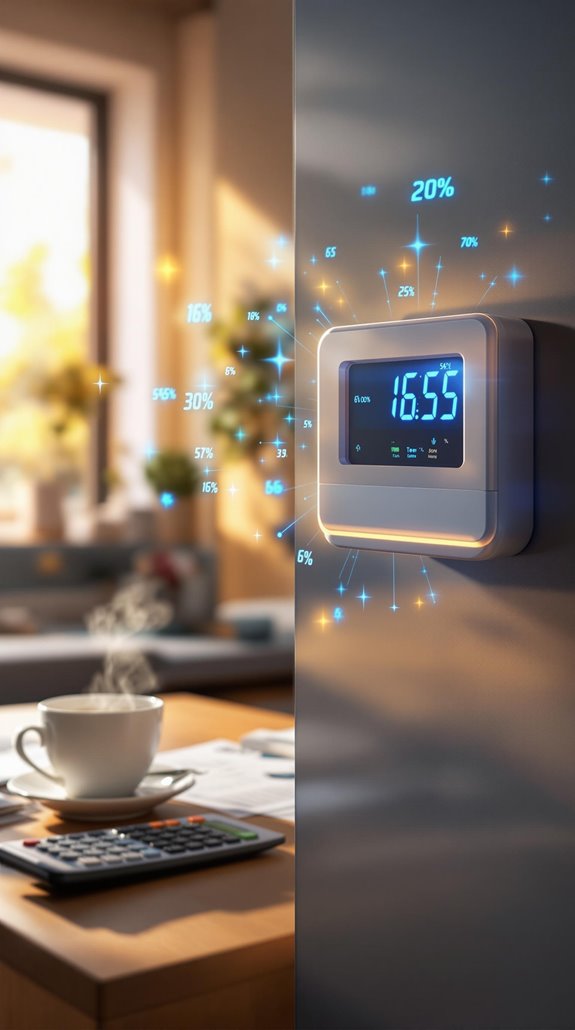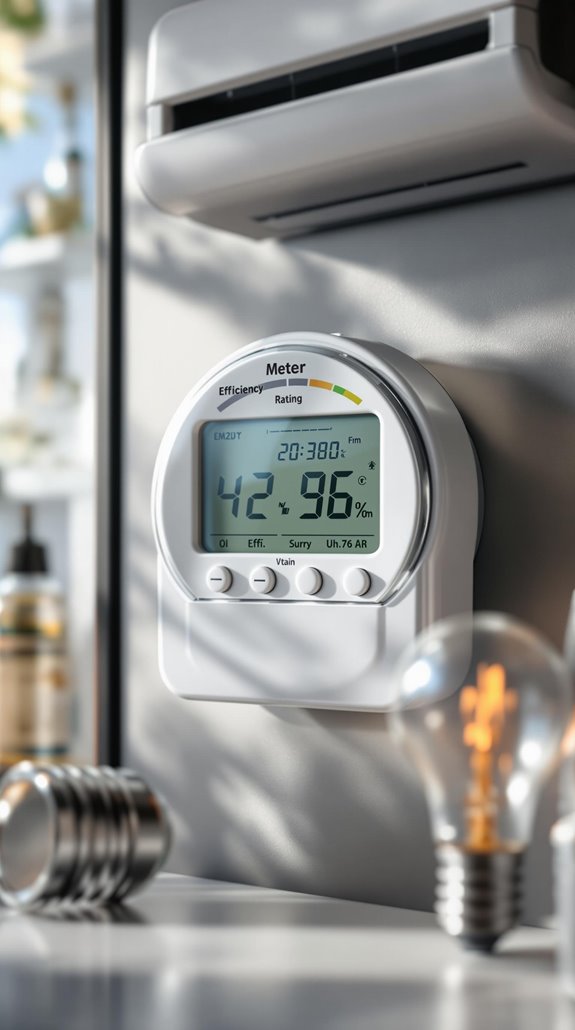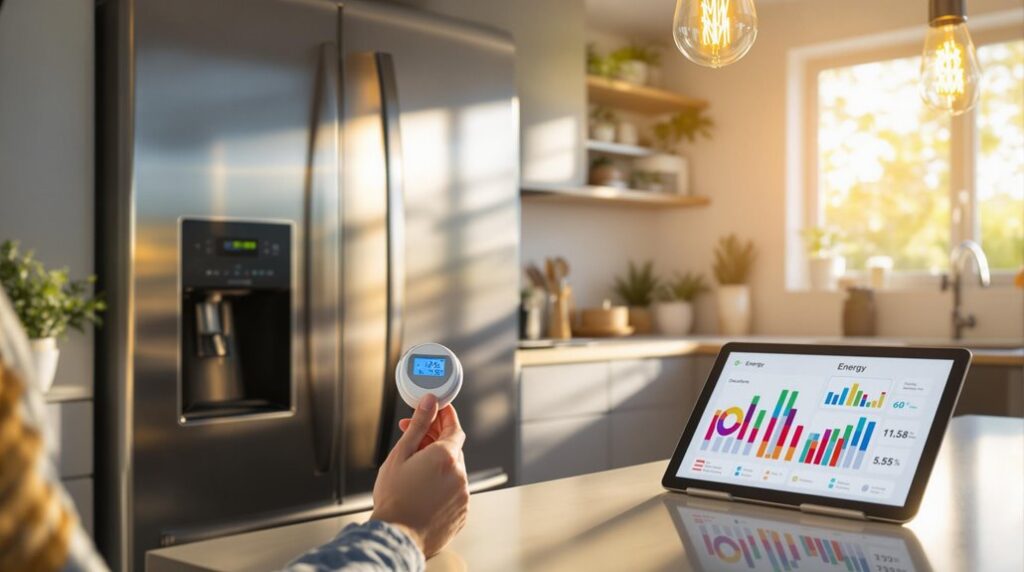I’ll show you exactly how to calculate energy efficiency using a simple formula that can slash your utility bills by 20-30% annually. Most people don’t realize they’re overpaying because they can’t properly measure their equipment’s performance against industry standards. The calculation involves dividing useful energy output by total energy input, but there’s a critical step most homeowners miss that determines whether you’re actually saving money or just thinking you are.
Key Takeaways
- Energy efficiency is calculated using the formula: Efficiency (%) = (Useful Energy Output ÷ Total Energy Input) × 100
- Gather power ratings from appliances and utility bills, then multiply by usage hours to calculate total consumption
- Compare your normalized energy metrics against ENERGY STAR benchmarks to identify inefficient equipment requiring upgrades
- ENERGY STAR appliances deliver significant savings: washers save $550 lifetime, gas appliances reduce costs 8-60%
- Implement LED lighting, programmable thermostats, and regular audits to achieve measurable reductions in energy bills
The Basic Energy Efficiency Formula That Everyone Should Know

While energy efficiency seems complex, you’ll find the fundamental calculation surprisingly straightforward: divide your useful energy output by total energy input, then multiply by 100 to get a percentage. I’ll show you the formula: Efficiency (%) = (Useful Energy Output ÷ Total Energy Input) × 100.
This equation works universally—whether you’re evaluating your furnace, solar panels, or appliances. The key is maintaining consistent units throughout your calculation. Use joules, watts, or kilowatt-hours, but don’t mix them. Remember that power is the rate of doing work, expressed in watts, while energy represents the total capacity to do work.
Higher percentages mean better performance and lower energy bills. When you see 90% efficiency versus 50%, you’re looking at significant cost savings. This formula helps you identify which equipment upgrades will deliver the biggest return on investment for your home or business.
Step-by-Step Process for Calculating Energy Efficiency
Before diving into calculations, establishing a systematic approach guarantees accurate results and identifies the most cost-effective improvements. I’ll walk you through the five essential steps that transform raw energy data into actionable savings opportunities.
First, I define the scope and gather power ratings from appliances, operational hours, and utility bills. Next, I calculate total consumption by multiplying power ratings by usage hours, then sum everything into daily totals. The third step involves normalizing consumption by dividing total usage by square footage or occupancy, which is critical for understanding energy performance metrics.
For assessment, I compare normalized metrics against ENERGY STAR benchmarks to identify inefficiencies. Finally, I measure post-improvement consumption to calculate actual savings percentages and cost reductions. This systematic process assures we’re targeting improvements that deliver maximum financial returns.
Remember that energy consumption is typically measured in kilowatt-hours (kWh), which provides the standard unit for tracking and comparing energy usage across different appliances and time periods.
Essential Measurement Units for Accurate Calculations
When calculating energy efficiency, using the correct measurement units determines whether your analysis delivers actionable cost savings or misleading results. I’ll guide you through the essential units that matter for your calculations.
For electrical energy, you’ll work with kilowatt-hours (kWh) – the unit that appears on your utility bill. Thermal energy uses British Thermal Units (BTU), while heating and cooling capacity requires BTU per hour (BTU/h). When you’re analyzing building performance, you’ll encounter Energy Performance Index (EPI) measured in kWh/m²/year, which normalizes consumption across different building sizes.
Remember that efficiency calculations require matching units for input and output energy. Whether you’re measuring joules, kWh, or BTU, consistency guarantees accurate percentages that translate into real money saved on your energy bills. These standardized units provide the common language necessary for ensuring consistency and comparability across different energy measurements and systems.
Real-World Examples of Energy Efficiency in Action
Since theoretical efficiency percentages won’t pay your bills, I’ll show you how real buildings and facilities achieve measurable energy savings. The Bullitt Center generates surplus electricity annually through integrated solar panels, while VanDusen Botanical Garden cuts energy use 67% below standard buildings using living roofs and geothermal heating.
You’ll find similar results in residential applications—programmable thermostats reduce heating costs by 16%, and ENERGY STAR fixtures slash lighting consumption by 50-75%. Additionally, proper insulation can significantly enhance thermal efficiency and provide further savings on energy bills. Industrial facilities see even bigger numbers: IBM saved 16,500 MWh over two years through system retrofits, while waste-heat recovery systems repurpose 80% of excess thermal output.
These aren’t theoretical savings—they’re documented results you can replicate in your own projects. Energy-efficient buildings also deliver enhanced durability that significantly reduces long-term maintenance expenses.
Common Efficiency Ratings Across Different Systems

Anyone shopping for energy-efficient equipment encounters a maze of ratings, scores, and certifications that claim to measure performance. I’ll break down the key systems you’ll encounter.
For cooling systems, I look at SEER and EER ratings. Higher numbers mean better efficiency—a 16 SEER unit saves about 13% more energy than a 14 SEER model. That translates to real savings on your utility bills.
ENERGY STAR certification means appliances use 10-50% less energy than standard models across 75+ product categories. It’s a simple pass/fail system.
HERS scores rate whole homes on a 0-100 scale where lower is better. A score of 85 qualifies for ENERGY STAR certification in most areas. These ratings also assess the energy performance of homes, which can influence home value and marketability.
Understanding these ratings helps you make informed decisions that impact your energy costs long-term.
Proven Strategies to Optimize Your Energy Performance
Knowing your equipment’s efficiency ratings is just the starting point—you’ll need actionable strategies to maximize your actual energy performance.
I recommend implementing real-time monitoring systems that track your consumption patterns and automatically flag inefficiencies. You’ll want to install programmable thermostats, which typically save 10% annually on HVAC costs, and presence detectors that shut off lighting in unoccupied areas. Additionally, considering a heat pump ventilation system can enhance your home’s energy efficiency by effectively transferring heat between indoor and outdoor air.
Upgrading to LED lighting cuts energy use by 75% compared to incandescent bulbs, while ENERGY STAR appliances deliver immediate savings. I’d also suggest participating in demand response programs—shifting high-consumption activities to off-peak hours reduces your utility rates considerably.
The key is combining smart controls with predictive maintenance. This approach helps you catch equipment failures before they waste energy and money. Additionally, conducting regular energy efficiency audits enables you to assess current consumption patterns and systematically identify areas of waste that might otherwise go unnoticed.
Money-Saving Benefits of Higher Efficiency Equipment
While optimizing your current systems delivers immediate gains, upgrading to higher-efficiency equipment transforms your long-term financial picture through compounding savings that often exceed initial investment costs within 12-24 months. I’ve seen ENERGY STAR washers save $550 in lifetime energy costs, while certified ceiling fans cut energy use by 60%. Here’s what you’ll gain: natural gas furnaces outperform electric heat pumps for cost efficiency in 41 states, and ENERGY STAR gas appliances reduce lifetime expenses by 8-60% compared to conventional models. Central air conditioners meeting these standards operate at least 8% more efficiently than baseline units. Even upgrading from a minimum-efficiency natural gas furnace to an ENERGY STAR model delivers energy savings and emissions reductions in every state. By investing in energy-efficient appliances, you’re joining millions who’ve prevented $500 billion in energy expenditures since 1992 through strategic equipment upgrades.
Environmental Impact of Improving Energy Efficiency
Beyond the immediate financial returns from efficiency upgrades, your equipment decisions directly shape our planet’s environmental future through measurable reductions in greenhouse gas emissions and air pollutants. When you invest in energy-efficient systems, you’re joining a movement that’s prevented 4 billion metric tons of greenhouse gases since 1992 through ENERGY STAR alone. Your choices matter—without efficiency improvements since 1980, our national energy consumption would be 60% higher today. Additionally, improving air tightness in homes can further enhance energy efficiency by significantly reducing heating costs.
The technical impact extends beyond carbon reduction. Efficient equipment cuts sulfur dioxide and nitrogen oxides by thousands of tons annually, reducing fine particulate matter that affects community health. These pollution reductions deliver $7-17 billion in public health benefits yearly. In 2020 alone, energy savings equated to over 5% of U.S. total greenhouse gas emissions reductions. By choosing efficiency, you’re contributing to cleaner air while lowering your operating costs—a win-win investment strategy.
Building and Industrial Applications for Maximum Savings
When you’re ready to implement energy efficiency measures that deliver measurable returns, establishing accurate baselines becomes your foundation for tracking real savings and calculating ROI. I’ll help you focus on the most impactful applications that fellow efficiency professionals consistently recommend.
For buildings, prioritize high-impact retrofits: LED lighting conversions, variable-speed drives, and enhanced insulation. You’ll see immediate EUI improvements when you optimize HVAC schedules and deploy building automation systems with AI-driven occupancy forecasting. According to a guide on affordable home renovation costs, investing in energy-efficient materials can also lead to significant long-term savings.
Industrial facilities achieve maximum kWh savings through waste-heat recovery systems and high-efficiency motors. Track your kilowatt-hour reductions per unit of output—this metric resonates with stakeholders evaluating project feasibility. Buildings account for 39% of CO2 emissions in the U.S., making these efficiency investments crucial for environmental impact reduction.
Conclusion
I’ve shown you the technical formula and practical steps to calculate energy efficiency, but the real value comes from implementation. Start measuring your equipment’s kWh consumption today, compare it against ENERGY STAR benchmarks, and identify your biggest energy drains. Every percentage point of efficiency improvement translates directly to cost savings on your utility bills. Don’t wait—those inefficient appliances are costing you money right now.
References
- https://galooli.com/blog/calculate-energy-efficiency/
- https://www.ngs.inc/how-to-calculate-the-energy-efficiency-of-a-building/
- https://www.electricrate.com/efficiency-calculation/
- https://www.omnicalculator.com/physics/efficiency
- https://study.com/learn/lesson/calculating-energy-efficiency-formula-method-conversion.html
- https://www.rff.org/publications/explainers/energy-efficiency-101/
- https://www.energysage.com/energy-efficiency/ee-savings/
- https://aemaco.com/2024/09/06/how-to-calculate-energy-consumption/
- https://solarscreen.eu/en/blog/calculate-building-energy-efficiency
- https://19january2017snapshot.epa.gov/statelocalclimate/calculating-energy-savings

